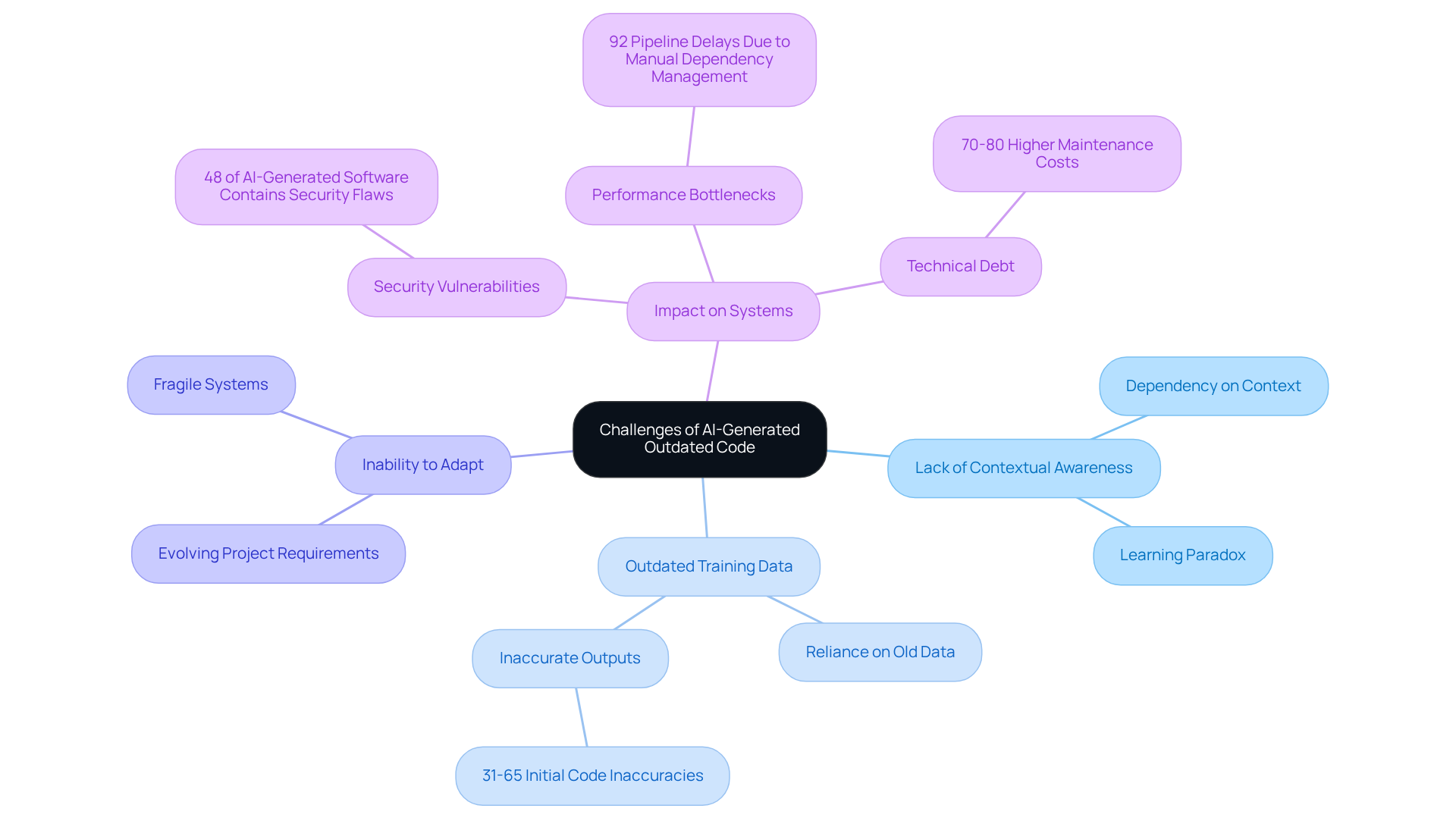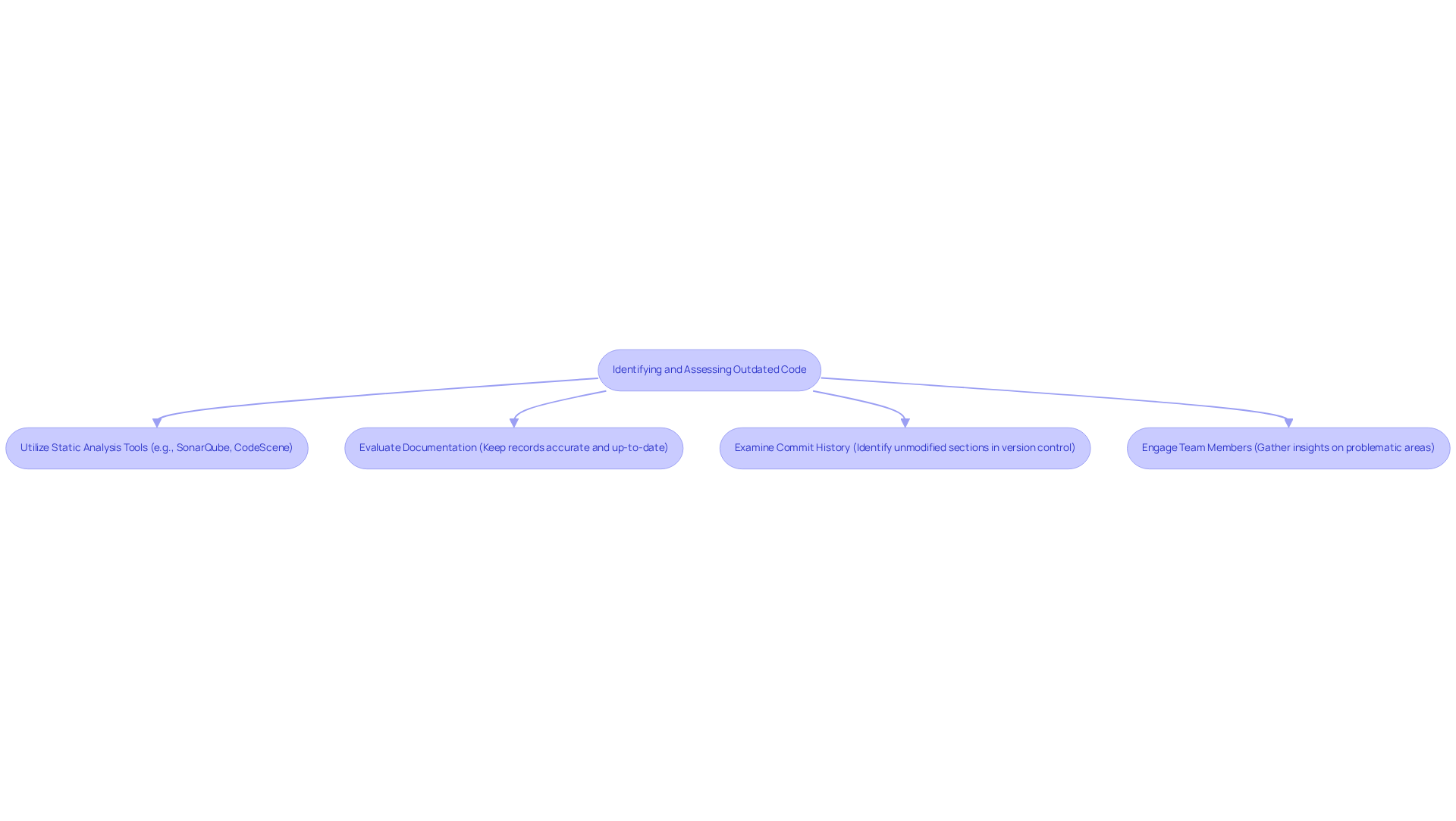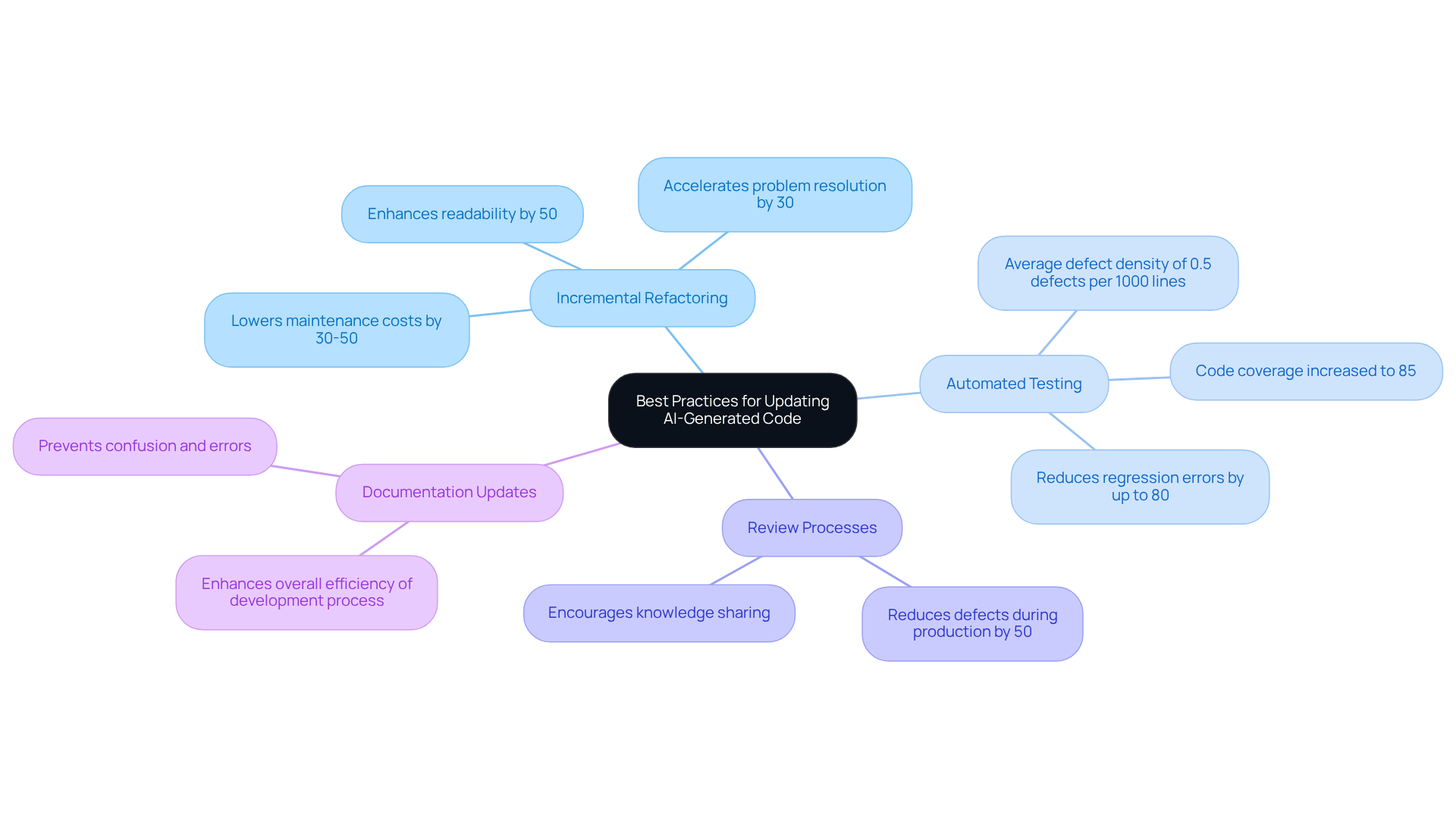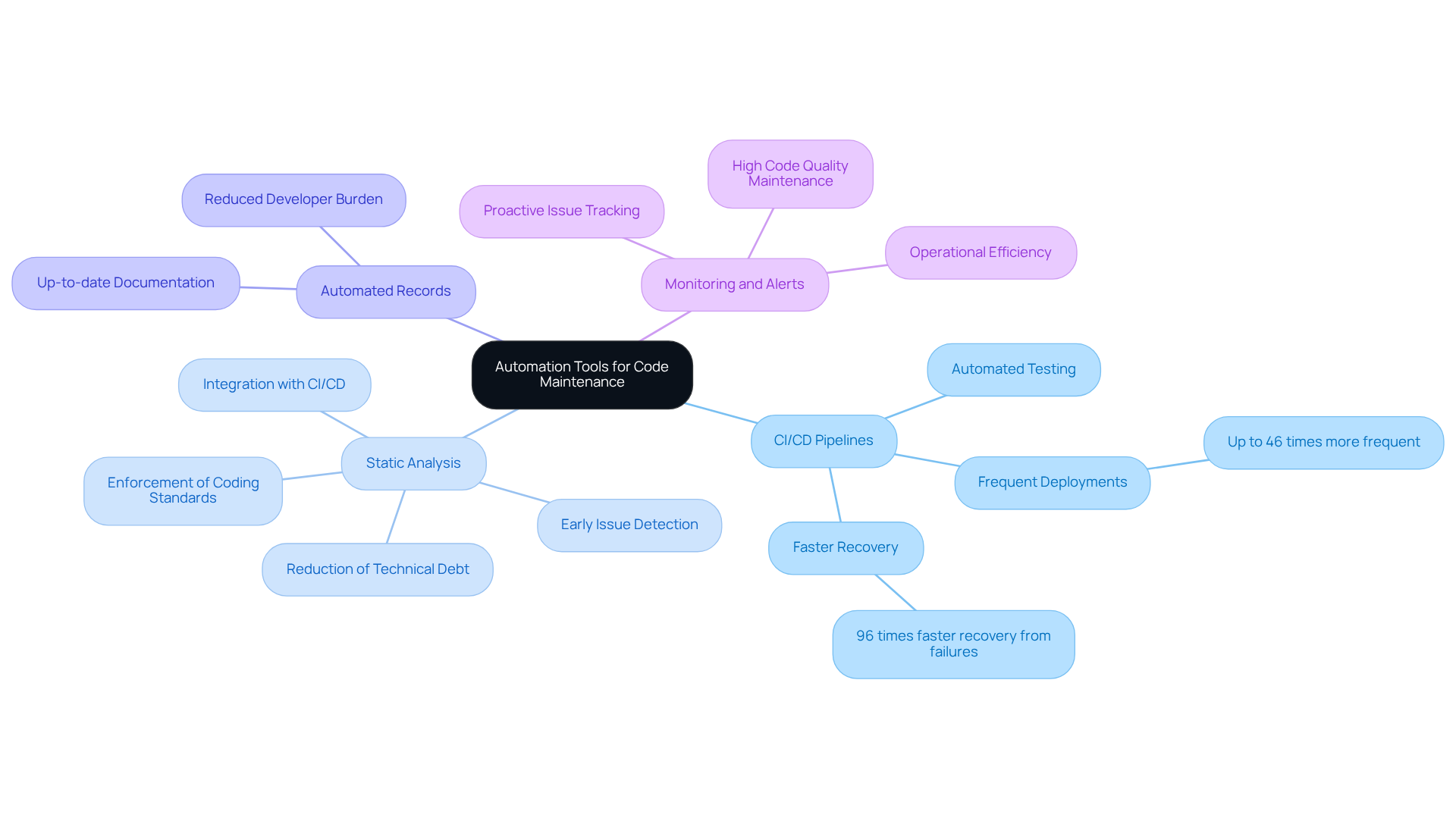Overview
In the ever-evolving landscape of software development, developers frequently encounter the challenge of maintaining and updating outdated AI-generated code. This task can be daunting, often leading to increased technical debt and reduced productivity. So, how can developers tackle these coding challenges effectively?
Enter Kodezi, a platform designed to streamline the coding process. With features such as incremental refactoring and automated testing, Kodezi empowers developers to enhance their code quality systematically. Furthermore, the integration of CI/CD pipelines ensures that updates are not only efficient but also reliable, paving the way for smoother development cycles.
Imagine the productivity gains when you can automate routine tasks and focus on more complex coding challenges. By utilizing Kodezi, developers can significantly reduce the time spent on manual updates, leading to a more efficient workflow. In addition, the systematic approaches promoted by Kodezi help in minimizing technical debt, allowing teams to maintain high standards in their codebase.
Are you ready to elevate your coding practices? Explore the powerful tools available on Kodezi and experience firsthand how they can transform your development process. With Kodezi, you’re not just updating code; you’re enhancing your overall productivity and ensuring the long-term success of your projects.
Introduction
In an era where software development is evolving at a rapid pace, the challenge of managing outdated code generated by AI systems has become increasingly significant. Developers often face the daunting task of addressing technical debt and security vulnerabilities that accompany these AI-generated scripts. This article explores effective practices for updating such code, emphasizing the critical need for developers to enhance code quality and maintain robust systems.
Furthermore, as organizations grapple with these challenges, the question arises: how can teams leverage innovative strategies and tools to not only tackle these shortcomings but also cultivate a culture of continuous improvement in their coding practices?
Understand the Challenges of AI-Generated Outdated Code
AI-generated scripts frequently contribute to outdated or inefficient systems, highlighting the need for an AI update outdated code due to several critical factors. These include:
- A lack of contextual awareness
- Reliance on outdated training data
- An inability to adapt to evolving project requirements
As projects expand, AI tools often struggle to maintain programming integrity, leading to significant issues such as security vulnerabilities. Studies indicate that 48% of AI-generated software contains security flaws, alongside performance bottlenecks and increasing technical debt. For example, organizations experience a staggering 92% of pipeline delays attributed to manual dependency management, highlighting the inefficiencies that can arise from an AI update outdated code.
Identifying these challenges is essential for effectively managing legacy systems and implementing AI update outdated code. This proactive approach enables teams to address potential issues rather than merely reacting to them. Industry specialists emphasize that the accumulation of technical debt from AI-generated programs can create fragile systems, which may perform well in controlled environments but falter under real-world conditions. This underscores the importance of ongoing monitoring and updating methods to maintain software quality and security.
Furthermore, as developers, have you considered how your coding practices might be impacted by these challenges? By exploring tools like Kodezi, you can enhance your productivity and improve code quality. With features designed to streamline dependency management and reduce technical debt, Kodezi empowers teams to tackle coding challenges head-on. In addition, the platform offers benefits that can significantly boost efficiency, allowing developers to focus on innovation rather than remediation.
In conclusion, addressing the pitfalls of AI-generated scripts is crucial for modern development practices. By adopting tools that facilitate better coding practices, developers can create robust systems that thrive in dynamic environments.

Identify and Assess Outdated Code in Your Projects
In the fast-paced world of software development, the necessity to ai update outdated code presents significant challenges that can hinder progress. To effectively identify and assess this outdated code, teams should adopt a systematic approach that encompasses several key strategies:
-
Utilizing static analysis resources like SonarQube and CodeScene can significantly enhance your code examination efforts. These tools scan the repository for deprecated functions, security vulnerabilities, and performance issues, providing valuable insights into software quality and maintainability. By prioritizing essential updates based on these insights, teams can ensure their code remains robust and efficient.
-
Furthermore, performing regular evaluations of documentation is crucial. Keeping records accurate and up-to-date ensures that they reflect the current condition of the program. Obsolete documentation can lead to misunderstandings and complicate maintenance efforts, making it essential to synchronize it with programming modifications.
-
In addition, examining commit history in version control systems such as Git can reveal sections of the project that have not been modified for an extended period. This analysis is instrumental in identifying areas that may require refactoring or modernization, ensuring the codebase remains relevant and effective.
-
Lastly, actively engaging with team members to gather insights on frequently problematic or challenging aspects of the system fosters a collaborative approach to software maintenance. Their firsthand experiences can guide prioritization, highlighting critical sections that need attention. By leveraging these strategies, teams can address the challenges of ai update outdated code and improve overall productivity.

Implement Best Practices for Updating AI-Generated Code
Developers often encounter significant challenges when they ai update outdated code to effectively refresh AI-generated code. Implementing best practices can streamline this process and lead to substantial improvements in productivity and code quality. Consider the following strategies:
-
Incremental Refactoring: Rather than implementing large-scale changes, adopt an incremental refactoring strategy. This method reduces risk and facilitates easier testing and validation of modifications. Research indicates that well-refactored software can enhance readability by up to 50%, which is crucial for onboarding new developers and accelerating problem resolution by approximately 30%. Furthermore, consistent software refactoring can lower maintenance expenses by 30-50%, making it a financially efficient approach over time.
-
Automated Testing: Establish a comprehensive suite of automated tests to ensure that updates do not introduce new bugs. Continuous integration resources can automate this process, offering prompt feedback on alterations. Utilizing tools like Kodezi CLI can further enhance this process by autonomously improving your codebase and fixing bugs before they reach production. Research indicates that groups employing automated testing reach an average defect density of 0.5 defects per 1000 lines, in contrast to 1.5 defects for those that do not, emphasizing the efficiency of automated testing in preserving software quality.
-
Review Processes: Cultivate an environment of reviews where colleagues can offer constructive feedback on modifications. This collaborative method not only aids in recognizing potential problems early but also encourages knowledge sharing among group members. Effective peer evaluations have been shown to reduce defects during production by up to 50%, reinforcing the importance of this practice.
-
Documentation Updates: Ensure that all modifications made to the code are accurately represented in the written records. Keeping records up to date is essential for preserving clarity and understanding within the team. Regular updates to documentation can significantly enhance the overall efficiency of the development process, as outdated documentation often leads to confusion and errors.
By implementing these practices, developers can ai update outdated code to enhance their coding efficiency and improve the overall quality of their software. Explore the tools available on the Kodezi platform to further elevate your coding experience.

Leverage Automation Tools for Continuous Code Maintenance
Automation software plays a vital role in the process of ai update outdated code to enhance the efficiency of software maintenance. Have you ever faced challenges in maintaining code quality? Here are some essential tools and practices to consider that can transform your approach to software development:
-
CI/CD Pipelines: Implementing continuous integration and continuous deployment (CI/CD) pipelines automates testing and deployment processes. This method guarantees that modifications undergo automatic testing and deployment, significantly lowering the risk of introducing errors into the production environment. Organizations that adopt CI/CD practices report up to 46 times more frequent deployments and 96 times faster recovery from failures. Isn’t it remarkable how these methodologies can revolutionize your workflow?
-
Static Analysis: Employing static analysis tools is essential for regularly assessing quality and detecting potential problems before they escalate. Tools such as ESLint and PVS-Studio help enforce coding standards and identify vulnerabilities early in the development cycle. By utilizing ai to update outdated code within CI/CD pipelines, teams can automatically scan software with each pull request, identifying vulnerabilities without manual intervention. This proactive approach not only enhances maintainability but also reduces technical debt over time. How could this impact your coding practices?
-
Automated Records: Utilizing instruments that ai update outdated code ensures that documentation remains accurate and up-to-date in response to program modifications. This reduces the burden on developers, allowing them to focus on coding rather than maintaining documentation, which is often a neglected aspect of software development. Wouldn’t it be beneficial to streamline this process?
-
Monitoring and Alerts: Creating monitoring tools to track software performance and notify teams of anomalies encourages a proactive strategy for software upkeep. By addressing issues before they escalate, teams can maintain high code quality and operational efficiency, ultimately leading to more reliable software delivery. How can monitoring enhance your team's responsiveness?
In conclusion, leveraging these automation tools not only addresses common pain points in software maintenance but also fosters a culture of efficiency and quality in development practices.

Conclusion
Addressing the challenges associated with AI-generated outdated code is crucial for maintaining the integrity and efficiency of modern software systems. Developers face common pain points, such as contextual awareness limitations and the reliance on outdated training data. By understanding these challenges, they can take proactive steps to ensure that their code remains robust and secure. Emphasizing the importance of ongoing updates and monitoring can significantly reduce technical debt and enhance software quality.
Key strategies such as:
- Incremental refactoring
- Automated testing
- The use of CI/CD pipelines
are effective methods for updating outdated code. Furthermore, by leveraging tools like Kodezi and employing static analysis resources, teams can streamline their coding practices. This ultimately leads to improved productivity and reduced maintenance costs. Regular documentation updates and collaborative review processes contribute to a culture of quality and efficiency in software development.
In conclusion, embracing best practices and automation tools not only enhances the updating process for AI-generated code but also fosters a proactive approach to software maintenance. By prioritizing these strategies, developers can create resilient systems that adapt to changing requirements and thrive in dynamic environments. Taking action now to integrate these practices will lead to stronger, more secure software solutions that stand the test of time.
Frequently Asked Questions
What challenges are associated with AI-generated outdated code?
AI-generated scripts often lead to outdated or inefficient systems due to a lack of contextual awareness, reliance on outdated training data, and an inability to adapt to evolving project requirements.
What are the consequences of using AI-generated code?
The consequences include security vulnerabilities, performance bottlenecks, and increased technical debt. Studies show that 48% of AI-generated software contains security flaws, and 92% of pipeline delays are attributed to manual dependency management.
Why is it important to identify challenges in AI-generated code?
Identifying these challenges is essential for effectively managing legacy systems and implementing updates to outdated code. This proactive approach helps teams address potential issues before they escalate.
How does technical debt affect AI-generated systems?
The accumulation of technical debt from AI-generated programs can create fragile systems that may function well in controlled environments but struggle under real-world conditions, underscoring the need for ongoing monitoring and updates.
What tools can help improve coding practices in light of these challenges?
Tools like Kodezi can enhance productivity and improve code quality by streamlining dependency management and reducing technical debt, allowing developers to focus on innovation rather than remediation.
What is the overall conclusion regarding AI-generated scripts?
Addressing the pitfalls of AI-generated scripts is crucial for modern development practices. By adopting tools that facilitate better coding practices, developers can create robust systems that thrive in dynamic environments.




